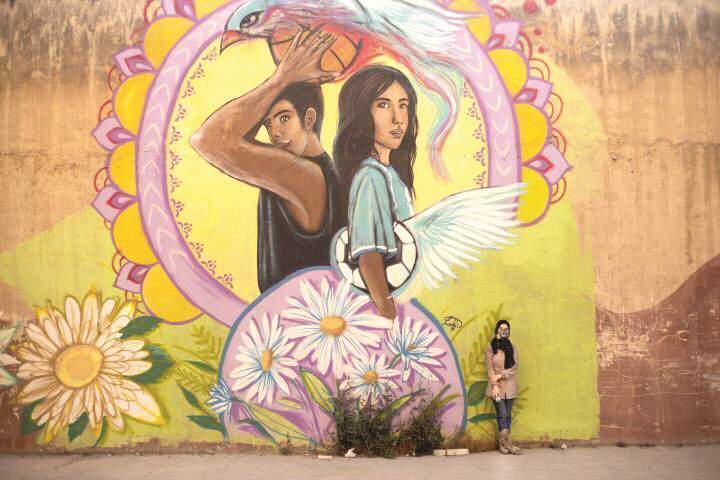AMMAN — In the heat of Israel’s 2014 war on Gaza, a
24-year-old Laila Ajjawi grabbed some spray cans and took to the streets of
Irbid’s refugee camp, hoping to paint a message of support across its walls,
amid high public sentiment against the Israeli aggression.
اضافة اعلان
“I had a vision when I first started doing graffiti. I found
that graffiti is a cultural weapon; it can be used in campaigns and can be used
to provoke (the average person’s) thinking on the streets,” Ajjawi told Jordan
News.
Seven years later, the painter-turned-graffitist believes
more than ever in the power of art to bring attention to issues that matter
through a process that she dubs “energy transfer”, Ajjawi said over the phone.
“I believe that the artwork can transfer energy to people. …
They will interact with it, then they will go around and talk about it with
other people, transferring the same energy yet again to others,” she explained.
Beyond battling oppression through her art, the muralist
said she also finds inspiration in the experiences of those around her, often
telling their stories through her work, to shed light on broader social issues.
“I did at least two murals that were inspired by our
neighbors back in the camp. They had a girl that I used to tutor and she was
doing great in school, but her family were very poor,” Ajjawi began.
“She was around 15 and we tried to talk to the mother to
convince her not to let the child get married, but unfortunately, all efforts
were in vain and she got married and dropped out of school,” she continued.
Her reaction was to take to a nearby alley and paint a young
woman, as if rising from a grave, and reaching out to a motto reading: “Right
to education.”
According to the artist, what happened to her neighbour is
not uncommon. Many of her acquaintances, including distant family members, she
said, have been through similar experiences.
Ajjawi pointed to the stark contrast between her experience
and that of her neighbor’s, noting that she and all three of her sisters have
graduated from university despite having also been raised in a refugee camp by
poverty-stricken families.
As a mother herself, Ajjawi has had to wrestle with the
pressures of balancing full-time motherhood and having a day job, and when
pressed to make a choice, she chose the former.
“Sanad, my three-year-old son, is basically my top
priority.”
“I stopped volunteering since I became a mother to spend
time with him. It is different now because I have a lot of things to consider
when I am going to do something. For example, if I am (going to be) away from
my son, who is going to babysit him?” Ajjawi questioned.
Ajjawi is among only a few women in her field but she
believes that viewers seldom care about that.
“People love art by nature. They look at the art before
looking at the gender of the artist,” Ajjawi said.
But it is not only passersby and commuters who enjoy
Ajjawi’s gift for expression. The local police are among her fans as well, she
joked, adding that they often stop to ask if she needs anything and, on
occasion, they take photos of her work.

Laila Ajjawi poses with one of her murals, in Irbid, during February 2020. (Photo: JNews)
Speaking on her “dearest” mural, aptly named “Peace and Tolerance”,
Ajjawi said that the municipality initially expressed concerns about the piece,
which was set to depict two women and a man across a large wall, worrying that
it would be on the receiving end of complaints from some of Irbid’s more
“conservative” members of the community.
“Many elderly men stopped me to ask why I was painting an
image of a woman in the street,” she said, recalling that when she would
confront them by saying, “‘I am a woman (too),’ they felt a little bit ashamed
of themselves because they were shaming a woman on the wall and I am a woman
myself.”
“I originally used three models for that painting, two girls
and a guy, but I ended up adding an elderly man with the same features as the
people who stopped me while painting,” she added.
Elaborating on the struggles that come with the territory of
being an artist, Ajjawi explained that the pandemic has taken a toll on her
prospects, as it has for many of her peers.
“Graffiti, and art in general, are now my main sources of
income. COVID-19 has changed a lot of things for me. Many projects were
cancelled because the people in charge of these projects had to invest money in
something else — more basic — like rent,” she explained.
“I would love, as an artist, to get good support, to the
point where I could reflect my own ideas in the streets. Without having to work
for someone else; to have my own freedom, so that I can send good messages that
we really need in our community, while supporting myself financially,” Ajjawi
said, hoping to remain true to her purpose as continues the pursuit of her
dream.



